You’re not running against anyone, but you’re running with everyone.
– RUN AS ONE, the Two Oceans Marathon movie
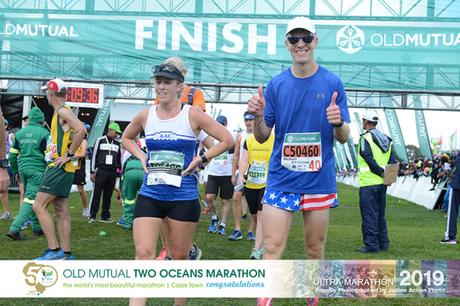
In True at First Light, Ernest Hemingway wrote that “I never knew of a morning in Africa when I woke that I was not happy.” This would be the first time I’d felt inclined to disagree.
Groggily glancing at my iPhone, I scanned the email twice to ensure I’d read it correctly. Though written in English, the words struck me as gibberish. And they certainly didn’t tread lightly on my brain first thing in the morning, less than 24 hours before the scheduled start of the 50th annual Old Mutual Two Oceans Marathon (OMTOM):
Today, following the South African Police Services Priority Meeting for the Old Mutual Two Oceans Marathon… the Two Oceans Marathon NPC Board has been informed that disruptions along the Ultra Marathon route, are a credible and real threat to Event safety.
The Two Oceans Marathon NPC has, after comprehensive and careful consideration, implemented a route diversion for the 56km Ultra Marathon.
Diversion? What kind of diversion? Quickly my eyes scanned the next few paragraphs before alighting on this disheartening detail:
A roll-out plan is in place to communicate this decision regarding the alternative route taking runners through Ou Kaapse Weg and not along Chapmans Peak.
My heart sank at the phrase — not along Chapmans Peak. What followed was an unsuccessful attempt to soften the blow, a mask of optimism as convincing in its sincerity as the smiley face emoji at the end of a text:
We are confident that this route deviation will still live up to the promise of our milestone 50th marathon celebrations.
Appropriately, the email closed with a hopeful promise that would go unfulfilled, as this would be the last we’d hear from the organizers for the next six days:
We will consistently update you on the progress.
And just like that, the Two Oceans Marathon was officially down to one ocean — and the lesser one at that.
Not a great start, I mused as I gazed out the patio window of our small but comfortable room at the Victorskloof Lodge. Absentmindedly I admired the expansive view of Hout Bay in the distance — the strikingly blue body of water and eponymous town nestled against its shores. Both sat sheltered by low-lying mountains, the entirety set against a backdrop of cloudless blue sky.
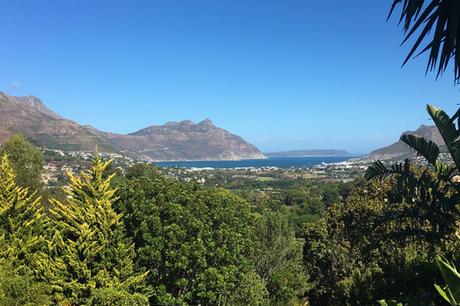
Hout Bay, both the inlet and the town, seen from the Victorskloof Lodge
Now my gaze fell, ironically enough, on the eastern edge of the visible mountain range and the aforementioned Chapman’s Peak. Chapman’s Peak Drive runs along and above Hout Bay, hugging the Atlantic coastline on the western edge of the African continent. With its “king of the world” perspective and sweeping views of the Atlantic Ocean, Chapman’s Peak is a highlight not only of the Two Oceans Marathon course but of the broader Cape Town experience. In fact, when you see photos of the Two Oceans Marathon on the race website or elsewhere, chances are you’re seeing a photo taken along Chapman’s Peak. And it’s precisely this section of the course that earns the event its not-so-humble nickname as “The World’s Most Beautiful Marathon.”
(Never mind that Two Oceans does not in fact offer a marathon, but rather an ultramarathon and half marathon, with the distance for the ultra being 56 km, or closer to 35 miles. As it turns out, in South Africa anything equal to or longer than 42.2 km, or 26.2 miles, falls under the convenient heading of “marathon” — take, as an extreme example, the nation’s most popular race, the 90 km Comrades “Marathon.”)
So then, to put this in American-speak, removing Chapman’s Peak from the Two Oceans ultramarathon course (the half marathon would be unaffected) would feel a bit like the New England Patriots finding out on Saturday that Tom Brady would be unavailable to play in the Super Bowl the next day. Certainly, the show must go on… but there was no denying some of the magic would be lost.

The view we’d be missing from Chapman’s Peak Drive 😢
At the same time, I like to think I’m an easygoing, roll-with-the-punches sort of guy, and here I was beyond fortunate to be back in South Africa to celebrate the 50th anniversary of one of the world’s most iconic running events. So I could hardly protest this minor inconvenience without sounding like an entitled (to use the Afrikaans term) chop — and especially when viewed through the lens of those potentially involved in any race day “disruptions.”
South Africa is a multifaceted nation that, thanks in large part to the visionary leadership of Nelson Mandela, has come a long way in its struggle to overcome a recent history shaped and scarred by apartheid. Nonetheless, the potential for disruptive protests along the race route highlighted how much work still remains in the nation’s quest to weed out corruption and increase socioeconomic opportunities for all its people. Coming from the United States, itself a country of ever-increasing corruption and economic inequality, the irony wasn’t lost on me.
So I’d be lying if I said the 11th hour route diversion didn’t let some of the air out of my Two Oceans balloon, and particularly since no other race course on the planet promises to lead its runners along two of the world’s five oceans. That said, we weren’t in South Africa for the third time in three years simply to run another race. Because my personal love and respect for the nation and its people extend far beyond start and finish lines.
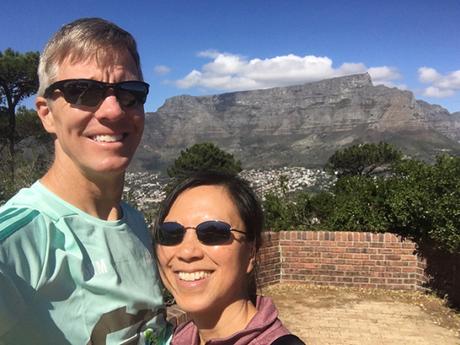
Table Mountain is the centerpiece of Cape Town
The Old Mutual Two One Ocean Marathon (start – 14 km)
And on the topic of start lines: There’s no aroma quite like that of an African start line on race day. The au naturel tang in the air reminded me—as so many aspects of the weekend would—of my experiences running Comrades the previous two years and the Victoria Falls Marathon two years earlier. And I could easily see how deodorant might not be priority #1 on a day we’d all be running 56 km up and down hills.
A cool mist fell from the predawn sky, appearing like tiny swirls of confetti in the electric streetlamps illuminating Main Rd in the Newlands neighborhood of Cape Town. Here alongside the Sports Science Institute of South Africa, nearly 14,000 strong stood awaiting the start of the 50th Two Oceans Marathon.
With more than 19,000 starters in 2019, Comrades is the world’s largest ultramarathon. Two Oceans, however, is second — and it’s not even close. Both are road races, unlike the typical US ultramarathon which takes place on dirt paths and off-road trails. Maybe not coincidentally given their history and resilience, the South Africans love their tests of endurance. And any athlete who has run either race will tell you this nation knows how to host an ultramarathon.
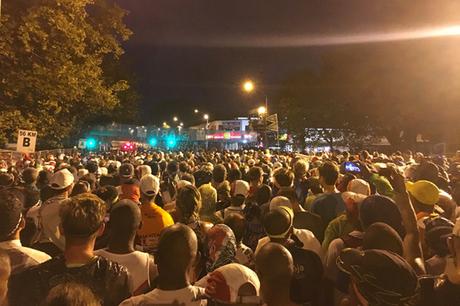
Love thy neighbor: the crush of the start corrals
Despite traffic and GI issues, I’d arrived in plenty of time on this Saturday morning to comfortably find my place in the C corral among the 3:30-4:00 marathon qualifiers. The light rain continued during the playing of “Shosholoza” (which lacked the power and resonance of the Comrades version) and the national anthem, then abated with the first notes of — “Chariots of Fire”? Seriously, Two Oceans?
If imitation really is the sincerest form of flattery, I’m guessing Comrades feels beyond flattered. That said, it’s unclear to me why Two Oceans would want to present itself as a wannabe version of the Ultimate Human Race, because that’s not a comparison it can win. In fact, according to the race website, OMTOM “was never intended to be anything more than a training run to enable Cape Town runners to prepare for the Comrades Marathon.”
The {CRACK} of the starter’s pistol jarred me out of my reverie, and the mass of bodies inched forward. Two minutes later I was crossing the start line and passing the brightly lit red signage of the Butlers’ Pizza joint that I had no doubt was popular in this college neighborhood just blocks from the UCT campus.
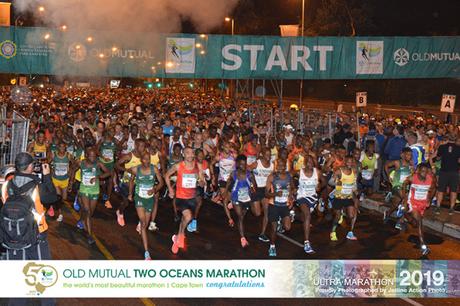
Two minutes to cross meant my “A” goal was now 6 hours, 18 minutes, which would get me across the finish line at the University of Cape Town (UCT) Rugby Fields by 1:00pm, well ahead of the 2:10pm cutoff. A modest goal to be sure, but with eight all-nighters in a three-week span (courtesy of our RaceRaves March Lunacy tournament) leading up to race day, plus a pulled hamstring suffered two weeks earlier in training, simply finishing 56 km while enjoying the journey would suit me juuust fine. After all, no matter my time, the second I crossed that finish line I’d be leaving South Africa with a 56 km personal best.
The darkness slowly lifted as we moved along this lengthy opening stretch of Main Rd, past university buildings and through upscale commercial neighborhoods. Our surroundings struck me as nicer than the start of either Comrades run (in Durban or Pietermaritzburg), though as we ran I did note what seemed like a disproportionate number of auto dealerships.
I started with the six-hour pace group to protect and gauge my ailing hamstring; that way, even if I were to fall off the pace a bit, I’d leave myself a safe margin of error to hit my goal of 6 hours, 20 minutes (gun time).
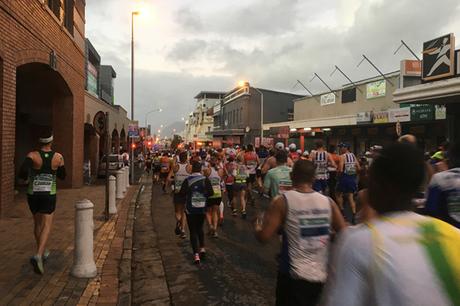
For the first few miles, I focused on the excited chatter around me while reading the backs of shirts to get a sense for all the different running clubs represented. As at Comrades, oversized bib numbers were worn on both the front and back and showed the number of half and ultramarathon finishes (in my case, zero and zero). Red numbers like mine were reserved for international runners, yellow numbers identified runners with nine “voyages” (i.e. finishes), and blue numbers signified members of the Blue Number Club—the equivalent of the Comrades Green Number Club for runners with at least ten OMTOM voyages to their credit.
Miles 3, 4 and 5 clocked in at a too-speedy 9:00/mile. So far so good for the hamstring, and I could practically feel the relief coursing through my bloodstream. With a long way to go, though, now was not the time to get cocky, not with the distance and hills still ahead of me. But this was certainly a good start.
Though not a true test of its integrity, I’d actually taken the hamstring for a test run at Friday morning’s Cape Town International Friendship Run, a fun 5.6 km shakeout through the fog along the tourist-friendly V&A Waterfront. Many different nations had answered the call of friendship with flags flying proudly, national colors on full display, and particularly strong representation from India, the UAE (specifically Dubai) and neighboring Zimbabwe. And after the race, we’d stuck around to watch the festivities as the organizers gave away prizes to anyone who correctly answered OMTOM trivia.
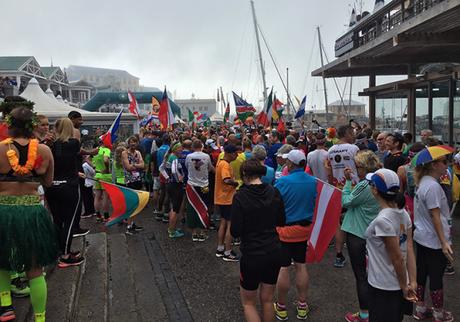
Patriotism was on full display at the International Friendship Run
Though I’d not memorized today’s alternate route, I knew the “One Ocean” contingency course deviated from the Two Oceans original around the 15-mile (25 km) mark. Until then, it would follow a relatively flat trajectory that would seek to lull us into a false sense of security before the nastiness to come.
I heard a voice close behind me, felt a tap on my shoulder and glanced over to see globetrotter and RaceRaves member extraordinaire Johannes Heym fall into stride alongside me. I’d first met Johannes, a German native living in Zurich, online through RaceRaves a couple of years earlier and had since been following his racing exploits around the world with a healthy mix of envy and interest. So meeting him here and now for the first time in mid-race, thousands of miles from either of our home countries, felt like “crazy runner” kismet.
Johannes had recognized me by my distinctive red, white and blue running kit with its American flag shorts and Lady Liberty calf sleeves; at this early hour I’d not yet donned my $5 Stars & Stripes sunglasses from Target, which had served me surprisingly well at Comrades 2018. He’d earned a corral “A” seed closer to the front, but having run Boston just five days earlier, he’d be running more of a “victory lap” race in Cape Town.
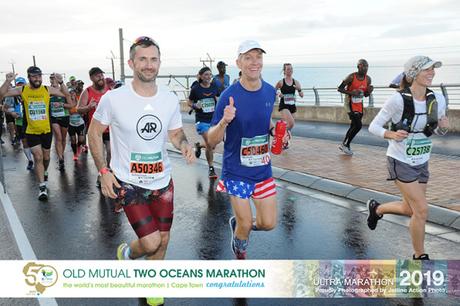
Johannes and I are cruise through Muizenberg in high spirits
For anyone who thinks running Boston 2 Big Sur six days apart is a challenge (and it is), try doing Boston 2 Two Oceans five days and 7,700 miles apart.
Johannes and I would run together for roughly 10 km until around the half marathon (21 km) mark, keeping each other in check while chatting about our travels and our lives. For me it was a race highlight and another reminder of why I love running all around the world.
He briefly introduced his fellow Adidas Running Club members from London who were running behind us, one of whom addressed me with perhaps just a hint of sarcasm in his voice: “Wouldn’t guess where you’re from.” And I hadn’t even had to write Ask me about my imbecile of a president on the back of my shirt…
During this time I felt a light drizzle on my skin and remarked to Johannes that the light rain felt good. As if on cue, the drizzle morphed into a steady rain. “This is a bit more than a light rain,” he noted matter-of-factly.

Ah, but here we were in one of the most breathtaking cities on the planet, and so the brief shower quickly yielded to a vivid rainbow framed on a canvas of palm trees and distant mountains. All we needed now was for a unicorn to pass in front of the rainbow and disappear into the clouds. The sudden humidity concerned me a bit (luckily I don’t cramp); at the same time, the scene struck me as a fitting commercial for The World’s Most Beautiful Marathon.
From there, and for pretty much the rest of the way, the weather would be near-perfect, with a cooling breeze in places and plenty of shade through the many neighborhoods we’d visit. A perfect fall day for a long run.
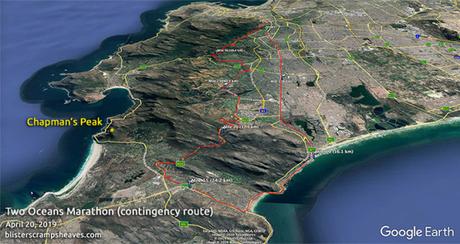
(Click on image for a higher-resolution view)
One ocean to rule them all (15–25 km)
Spectators lined the route in Muizenberg where a human-sized, biped bunny stood high-fiving runners as we passed (this was Easter weekend, after all). All in all, there would be quite a few spectators along the route, though nothing like the throngs at Comrades — here bystanders were limited primarily to the residential neighborhoods, and I assumed most of them must live in the area since access to the course ranged from difficult to impractical.
Cruising through the seaside towns of St. James and Kalk Bay was a course highlight to be sure, although train tracks and electrical wires positioned between the road and water prevented a full appreciation of the tranquil coastal landscape. Still, though, running along the ocean with its coastline punctuated by the sheer cliffs of Simon’s Town in the distance would be the hands-down high point of just about any other marathon in the world, as it would be for us today with Chapman’s Peak out of the picture.
It struck me that running the traditional Two Oceans route would be much like running the Surf City Marathon and Big Sur Marathon, two of the most scenic marathons in the US, on the same day, with the Indian Ocean side being more reminiscent of Surf City’s beachfront course a stone’s throw from the ocean, and the Atlantic Ocean side evoking Big Sur’s grandeur courtesy of its sweeping views of the rugged coastline below Chapman’s Peak.

Brightly colored beach huts on Muizenberg beach, 17 km
That said… spoiler alert! At the risk of being labeled a killjoy (who, me?), the truth is that the Two Oceans Marathon course does not in fact run along two oceans (nor is it a marathon but hey, one fallacy at a time). Rather, we currently found ourselves running along False Bay, a celebrated body of water fed directly by the South Atlantic Ocean, not the Indian Ocean. That said, I’m guessing the race organizers won’t be changing the name to the “One Ocean Twice” Marathon anytime soon.
(As an aside, False Bay is one of the world’s most popular locations for viewing and interacting with great white sharks. In recent years, however, great white sightings have dropped precipitously, with no confirmed sightings reported in 2019. In June 2017, Katie and I had spent a day aboard a boat on False Bay, hoping to witness the sharks feeding on the buffet of plump and tasty seals cavorting off Seal Island. Alas, we’d had no luck, and now we know why — as it turns out a pod of orcas, i.e. killer whales, had moved into the area in 2015, preying on and replacing the great white at the top of the local food chain. The arrival of the orcas likely contributed to the great white’s subsequent vanishing act.)

Surfers flock to False Bay — yes, the same False Bay where great whites gather to hunt
I started to look for Katie shortly before the 16 km mark, and sure enough there she was, rain be damned, standing on the False Bay side of the road scanning the crowd. I introduced her quickly to Johannes, whom she immediately recognized — like me, she was tickled to see him. Snapping a quick selfie of the three of us, I accepted my bottle of Maurten from her and took off again, making plans to see her at the finish. I would have preferred not to carry my bottle for the next however many km, but with the inaccessible route precluding any further Katie support, I didn’t have much choice.
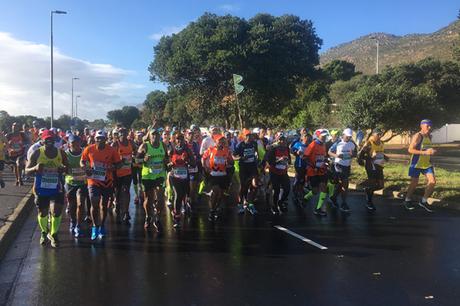
The wheels on the 6-hour “bus” go ’round and ’round, 25 km
At the 21 km (half marathon) mark we turned inland away from the bay and started our first real climb of the day through Fish Hoek. Johannes veered over to the right side of the road outside the main pack of 6-hour runners and accelerated just a bit, pulling ahead as we chugged uphill. Much as I would have loved to follow him, I had no intention of pressing my luck by pushing the pace now, and so I watched him disappear into the sea of sweaty bodies.
After about a mile of gentle climbing, which felt good as a warmup to prime the quads, the road descended down into Sun Valley, giving us a chance to regroup and prepare both mentally and physically for the grueling stretch to come. It was here that the course would deviate from the traditional Two Oceans route, starting with the toughest climb of the day.
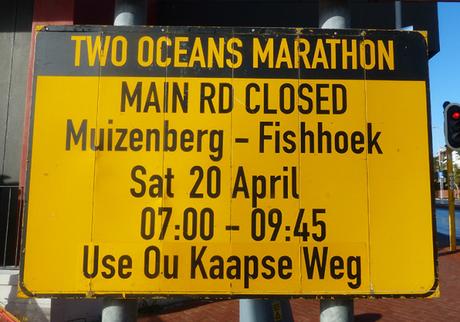
On second thought drivers, DON’T use Ou Kaapse Weg
It’s not the number of the oceans, it’s the size of the hills (26-38 km)
Twenty-four hours earlier, the ultramarathon had been rerouted and the relay canceled due to a “credible and real threat” of protests along the route. Fortunately, a contingency route had already been in place, having been deployed in 2015 when fires had made the road above Chapman’s Peak (“Chappies” in local parlance) unstable.
But aside from that communication, I’d had to dig through the comments on the race’s Facebook post to find a graph that compared the elevation profile of the two courses — and no sooner had I done so than I almost wished I hadn’t. The climb up Ou Kaapse Weg would be more than 50% steeper than the already arduous climb up to Chappies, with a nearly equal amount of downhill waiting on the other side. So assuming my quads survived the punishing four miles of uphill without flooding with lactate, they’d be easy prey for the brutal descent to follow.
All in a day’s work in South Africa.
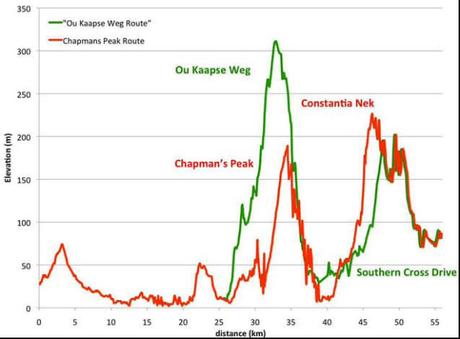
Elevation profiles for the traditional (red) vs. contingency (green) OMTOM routes
Turning right on the M6 where the two routes diverged, we began the steady climb up Ou Kaapse Weg. I’m typically stronger on uphills than downhills, and here I took the opportunity (as I do at many races) to pass a number of runners who slowed to either a shuffle or walk. I wasn’t moving fast by any means, but when confronting a bully like OKW, speed is all relative.
We climbed… and climbed… and climbed, and every so often I’d glance up from my shoe tops to gauge our progress. The thought crossed my mind: This hill will never freaking end. It didn’t help that the sun chose that moment to break through the clouds, albeit briefly, and I felt its unwelcome warmth on my skin.
I caught up to and passed Johannes before finally conceding to gravity and slowing my pace to a walk, as had everyone around me. Trying to steady my ragged breathing, I imagined how the leaders and eventual winners of the race must have flown up this hill with reckless speed, mind-boggling machines of human endurance.
From somewhere (was that an aid station?) the familiar melody of “Smooth” by Carlos Santana reached my cynical ears with more than a hint of irony, though I assume the song was actually meant to be motivational or entirely coincidental.
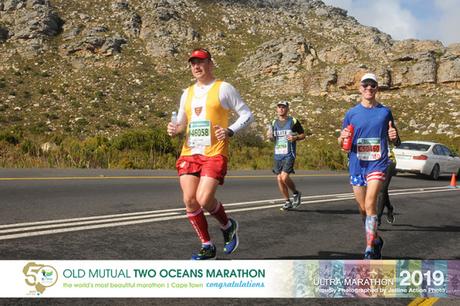
Climbing on Ou Kaapse Weg
Not surprisingly, there were few if any spectators on Ou Kaapse Weg. And as glorious as the views out over the surrounding hills were, I really could have cared less — as the road continued to climb, seemingly without end, I just wanted to be done.
Fortunately, as with all good things, all bad hills must come to an end, and luckily Ou Kaapse Weg ended before I did. Reaching the top where a yellow arch greeted us at the 33 km mark, I paused to take a photo of the city and surrounding countryside. That’s when I heard someone call my name.
“Michael!” I glanced back. An older gentleman in a blue bib number — meaning he’d completed at least ten “voyages” — addressed me in a South African accent (one of my favorite accents in the world, mate!), and I remembered the bib pinned to the back of my shirt. “Let me take your picture for you.” I thanks-but-no-thanksed him, not wanting to further delay either of us, but he wasn’t ready to take no for an answer. “Here, hurry, let me take your picture, you’re never coming back here.”
He had a point, and despite my fatigue I appreciated his generosity. Tiredly and a bit begrudgingly I handed him my iPhone. The resulting photo of me and the road was a poor substitute for the sprawling view stretched out below us, but again I appreciated his thoughtfulness. And I guessed that after 10+ finishes of his own, he now relished the chance to play ambassador and introduce newbies like myself to The World’s Most Beautiful Marathon.

I seized the moment to catch my breath before the course reversed trajectory and headed downhill. As gravity took over on the steep descent, I struggled to maintain control while battling the road’s awkward camber, which made every step challenging and uncomfortable. On top of that, with every footfall landing at an angle I soon felt the rub of blisters starting to form on both of my big toes. Awesome.
Johannes re-passed me on the downhill, and that would be the last I’d see of him in South Africa. I sipped on my bottle of Maurten every km or two and downed a GU, which did little for my energy levels. After the race, we’d receive an email from the organizers apologizing for a lack of water on Ou Kaapse Weg, which I didn’t notice and which no doubt affected runners closer to the back of pack.
Given the humidity, I drank more water along the course than I usually would — I was determined to avoid Coke in favor of Maurten, since too much Coke the year before had translated into some rough and bloated miles in the second half at Comrades. And with OMTOM being much closer to an actual marathon in distance, I knew I could prevail without the extra sugar.
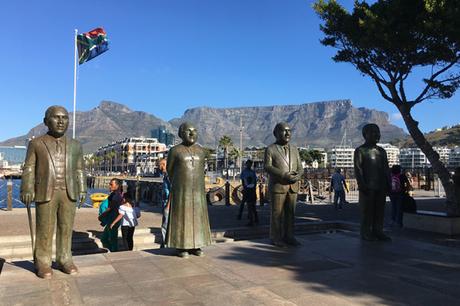
Nobel Square (with Table Mountain in the background) at the V&A Waterfront features sculptures of South Africa’s four Nobel Peace Prize winners (L to R): Albert Lutuli, Desmond Tutu, F. W. de Klerk, and Nelson Mandela
And about those aid stations — all along the course, I was surprised to see volunteers dispensing water from a spigot or hose attached to a source, rather than handing out the single-use sachets favored by other African races. The reason for my unease? From mid-2017 to early 2018, Cape Town had suffered a severe drought, with water levels hovering between 15% and 30% of total dam capacity. Thousands of miles away in the US, we’d watched helplessly as news reports out of South Africa had hammered home the fearful notion that a “Day Zero” would soon arrive when one of the world’s most celebrated cities would effectively run out of water.
The shortage had forced the city to implement emergency water restrictions in a bid to curb usage, an approach that, together with strong rainfall in June 2018, had restored water levels to nearly 70% of dam capacity and ended the water crisis. But even with the threat of Day Zero neutralized for the moment, I winced to see so much water being spilled and so many half-consumed cups being tossed aside, American-style. Admittedly, though, I was among the guilty, since it’s rare I can drink an entire cup of water on the run.
At last we arrived at the base of the Silver Mine Nature Reserve, where the course would largely level off for the next five miles. But the damage had been done, with Ou Kaapse Weg ruthlessly exposing my lack of preparation and peeling away the scab of eight all-nighters in three weeks. On the bright side, my hamstring was none the worse for wear after seven grueling up-and-down miles, and that was the most important thing. Earning that finisher medal was one thing, but doing so with a healthy hamstring would be the real victory.
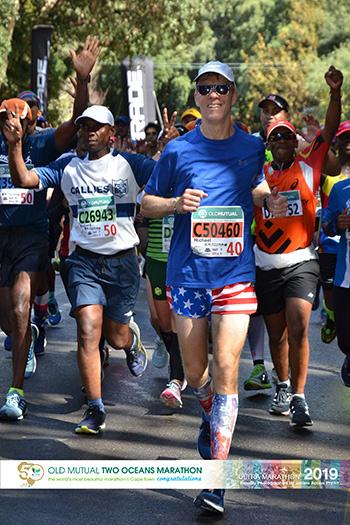
Keeping pace with the 6-hour bus
Keeping the faith: UCT or bust (39–56 km)
After Ou Kaapse Weg I could tell the second half would be a slow, deliberate affair. Near the 39 km mark we passed Pollsmoor Prison, followed immediately by the wide-open vineyards of Klein Constantia nestled up against the lush foothills of Table Mountain. Vineyards to the left of me, prison to the right, here I am…
We forged ahead on tree-lined roads through conspicuously secure neighborhoods where walls, gates, and high fencing topped with barbed wire stood as symbols of a nation struggling with severe socioeconomic disparity. Having visited the country in each of the past three years, one word I now associate with South Africa is security. This is in part because our good friend Rory is in the business, but more so because the nation suffers from a high rate of violent crime owing to its widespread inequality. If only the same rains that had filled the dams in Cape Town could wash away 50 years of apartheid…
A surprise Katie sighting at the 41 km mark lifted my spirits, though I dared not stop and rest for long lest my mind and body conspire on an immediate exit strategy.
“Why do all the cute ones run away?” asked one of the more memorable spectator signs of the day, and I was surprised to find I still had the energy to smile.
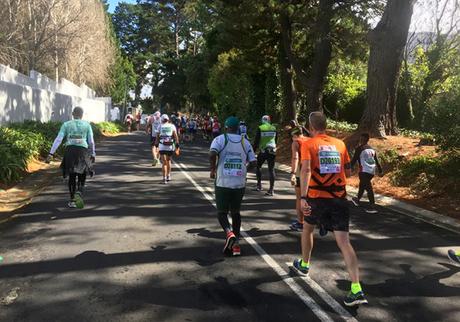
A whole lotta hiking and not much running on Southern Cross Drive, 47 km
The route turned uphill again in Constantia, and reaching 45 km (28 miles) we were confronted with our second gut-punch ascent of the day, a stretch of nearly 3 km up Southern Cross Drive. From this point on I walked portions of pretty much every uphill. My decision was as much psychological as it was physical — sure, I could’ve kept pushing with the goal of a sub-6-hour finish, but looking at the big picture I realized I had no desire to reflect back on the 50th Two Oceans Marathon and think, “Well, that pretty much sucked.” I wanted to bask in the experience and savor this opportunity as much as possible, because my friend atop Ou Kaapse Weg had a point — I may never come back here.
Luckily discomfort, like most things in life, is relative, and I kept consoling myself with the reminder that at least this wasn’t Comrades — no way would I have attempted (much less completed) 90 km on a wonky hamstring. In fact, after the past two years of running Comrades, flying all the way to South Africa — a trip comprising two flights of ~10½ hours each, one way — to run “just” 56 km felt almost like cheating.
Almost.
At 46 km I finished the last of my Maurten and tossed the bottle. My fingers felt like flypaper thanks to the liquid’s sugary viscosity.
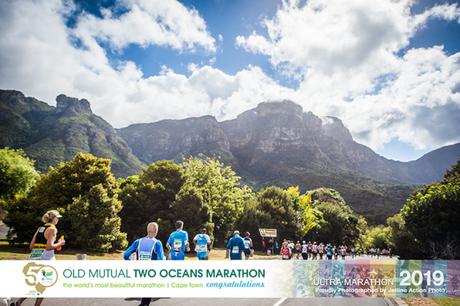
Approaching the Kirstenbosch National Botanical Garden, 52 km
The final 8 km began with a short out-and-back on Rhodes Drive. And here it occurred to me — there’s no better way to appreciate just how far a marathon really is than by adding another nine miles. Had it not been for Ou Kaapse Weg sapping much of my stamina so that pacing was no longer a concern, I’m not sure how I would have gone about pacing the entire 56 km.
My American flag shorts paid dividends in the second half, as sporadic chants of “U-S-A! U-S-A!” spurred me on, prompting me to lift my eyes and signal thumbs-up before returning to what felt like a zombie-esque shuffle. Surprisingly given its size and reputation, only 227 other Americans ran the 2019 Two Oceans Marathon, less than 2% of the total field size (though still stronger representation than at Comrades, where US runners account for less than 1% of the total). In all, 89 nations would be represented, with Germany leading all non-African nations with 549 entrants.
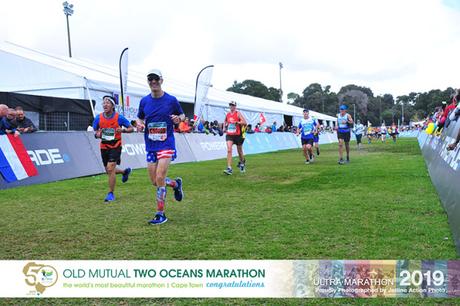
One last smile for the cameras in the home stretch, 56 km
Around the 50 km mark the 6-hour bus (pacing groups in South Africa are known as “buses”) passed me moving surprisingly briskly on a downhill, and I wondered what had taken them so long. At this point there was no way I was keeping up with them, nor did I want to try since I was well within my pre-race goal of 6 hours, 20 minutes. And so I bid them totsiens en baie geluk!
Treating the 55 km mark like a stop sign (a stark indication of just how tired I was), I slowed to a walk one last time along the wooded road, soaking in the cheers from the assembled spectators who urged us to the finish. Cresting one final hill, I summoned the last of my reserves before picking up the pace for a downhill run to the finish.
The home stretch on the UCT Rugby Fields was beautiful, a nice long straightaway on a wide swath of green grass with the finish line directly ahead. Torn between “bask in the moment” and “get this over with,” I directed my applause toward the spectators standing on either side of the barricades and crossed under the wide green arch in a 56 km personal best of 6:07:11, a decidedly unspeedy-but-not-terrible average pace of 10:30/mile. Best of all, my hamstring felt good.
I was spent, and for several seconds I stood just beyond the finish line, bent over with hands on knees — a familiar position for me in South Africa. Ironically, I was more gassed than I’d been after the previous year’s run at Comrades, where I’d felt downright ok after the race. Amazing what sleep and consistent training will do for you.
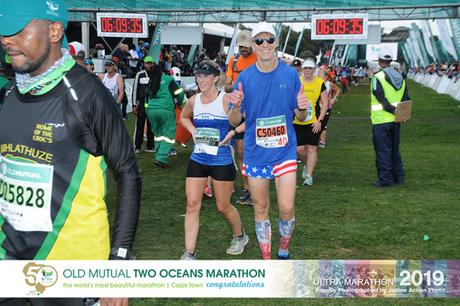
Call me a TOMboy (finish line)
Gratefully I collected my medal; I hadn’t realized (though I should have) that like Comrades, Two Oceans awards several distinct finisher medals based on performance, the details of which can be found on a cryptic page separate from the race website’s “Prizes & Medals” page. The page notes that all information is current as of 2018:
Top 10 men’s and women’s finishers: Gold
Sub-4 hours: Silver
Sub-5 hours: Sainsbury
Sub-6: Bronze
Sub-7: Blue
So then I assume anyone finishing between 7:00 and the 7:30 cutoff receives no medal…? 🤔
In essence I’d finished as the fastest of the slowest runners — that’s my story and I’m sticking to it. And now I understood why the 6-hour bus had moved past me with such purpose.
I threw my arms around The World’s Most Beautiful Spectator (Katie), then I collapsed on the grass in the fenced-in gathering area to, well, gather my wits. There I sat lounging when I glanced up to see speedy Chicago friend Krishna strolling in my direction. Like Johannes (who’d finished in 5:51:04 to earn a bronze medal) Krishna had run Boston five days earlier, and today as it turns out we’d finished in roughly the same time. But given his recent 3:05:01 personal best at the California International Marathon, I’m confident Two Oceans is the closest I’ll ever come to him at a finish line.
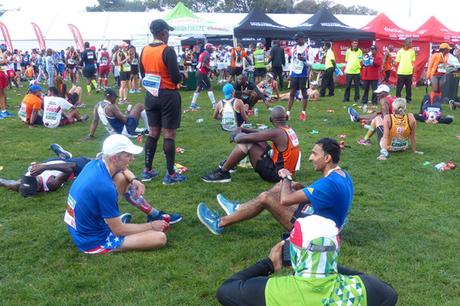
Comparing notes with Krishna after his first-ever ultramarathon
As we sat talking, South Africa’s most annoying public servant patrolled the gathering area, abusing the air horn she gripped tightly in one hand like Voldemort’s wand. Apparently her job was to create as much of a cacophony as possible so that runners would vacate the area quickly. And yet glancing around I didn’t understand why, because it was clear there was more than enough room here for runners to sit a spell and rest their weary legs.
Grudgingly we obliged, cutting short our conversation and fleeing the Recovery Nazi to reunite with Katie outside the fence. No matter, though, because we’d have the pleasure of Krishna’s company for dinner that evening at one of Cape Town’s much-heralded restaurants.
After exchanging goodbyes, I paid a visit to the TransAct Recovery Centre tent, where an awesomely aggressive masseuse waited to work her manual magic on my quads and hamstrings, to the tune of quite possibly the best R200 (~$14) I’d spend on our trip.
Katie and I then positioned ourselves at the finish line to witness the final minutes of the race. The countdown to the 7-hour, 30-minute cutoff lacked the high drama of Comrades’ 12-hour cutoff, with no human chain forming to deter latecomers. In fact, the best part of watching those last few moments was cheering South African legend Bruce Fordyce across the finish in a time of 7:16:57. Amazingly, despite winning Comrades a record nine times from 1981-1990, the 64-year-young Fordyce never won at Two Oceans (the disclaimer being, I’m not sure how many times he tried.)
And speaking of winners, one last link between the world’s two largest ultras: Bongmusa Mthembu, who’d worn the Comrades crown in each of the two years I’d run it, was the first runner to cross the OMTOM finish line in a fleet-footed time of 3:08:36, while fellow South African Gerda Steyn (who’d go on to set the course record for the Comrades “up” run seven weeks later) was the first woman across the line on the UCT Rugby Fields in 3:31:25.
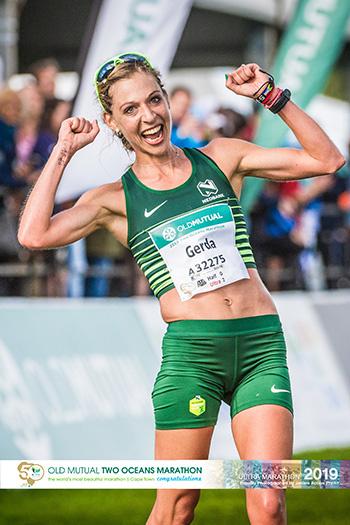
Gerda Steyn celebrates her 2019 OMTOM victory
With that, the finish arch came down on the 50th Two Oceans Marathon, and we slowly sauntered back to our car. Thanks to the rain-filled dams in Cape Town, a shower of reasonable length and warmth awaited us back at our lodge in Hout Bay, followed by two more days of exploring the Mother City. I didn’t need a Magic 8-Ball to tell me this would likely be our last visit to South Africa for a while. That said, the nation has an undeniable charm, vibrancy and allure all its own, and you can bet I’ll be eyeing the 100th Comrades Marathon in 2025.
But our third time on its shores had indeed been a charm, much like the first and second — and in many ways, South Africa now feels like a home away from home. If only it didn’t require 21 hours of flying to get from one home to another…
So while I’d not been able to experience the full beauty of Two Oceans, nor judge for myself its claim to the title of “The World’s Most Beautiful Marathon,” there’s only one 50th anniversary celebration. And I had experienced the #RunAsOne mindset that makes events like OMTOM and Comrades so special.
And hey, one ocean is better than no ocean at all.
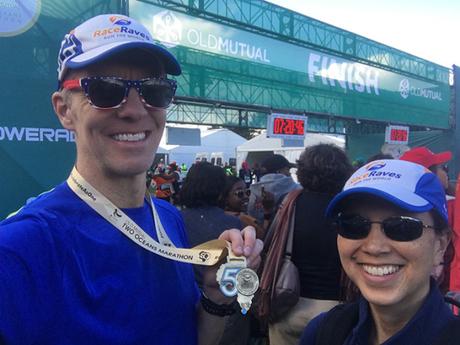
BOTTOM LINE: In a way, I feel like I’m writing this review with one hand tied behind my back — because I didn’t really run the Old Mutual Two Oceans Marathon. Sure, I completed 56 km along the official route within the allotted 7-hour, 30-minute cutoff time to earn my 50th anniversary medal. But due to the “credible and real threat” of disruptions (i.e. riots) along the original course, the race was rerouted to a contingency course that bypassed the iconic Chapman’s Peak section overlooking the Atlantic Ocean; thus, what we actually ran might best be described as the One Ocean Marathon. Never mind that at 56 km (35 miles) in distance, OMTOM is actually an ultramarathon. And never mind that neither route actually reaches the Indian Ocean; rather, each runs along False Bay which empties into — the South Atlantic. Not that I expect the organizers to rush to change the race name to the “One Ocean Twice” Marathon anytime soon.
And so despite all its positives, for this reason (exclusion of Chapman’s Peak) I couldn’t in good conscience give the 2019 edition five shoes. Because without the undisputed highlight of the course, Two Oceans is no longer “The World’s Most Beautiful Marathon.” Which means I now need to return to Cape Town to run the conventional OTMOM route. Two go-rounds at the same race? Sounds an awful lot like another South African race I know and love…
And speaking of that, having run the Comrades Marathon (OMTOM’s older, more brutish brother) twice in the previous two years, it was tough not to view Two Oceans as “Comrades Lite.” From the similar expos to the differentially colored bib numbers to the performance-based medals to the playing of “Shosholoza” and “Chariots of Fire” at the start, so much about this race hearkened me back to the Ultimate Human Race. And as the second-largest ultra in the world (behind only, yes, Comrades), OMTOM is undoubtedly the most popular qualifying race for athletes hoping to run Comrades two months later. It’s clear these two races captivate and dominate the running landscape of the nation.
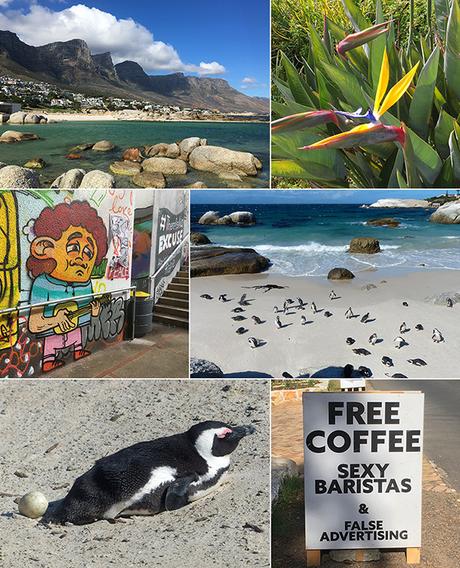
Cape Town, illustrated (clockwise from top left): The Seven Sisters in Camps Bay; Mandela’s Gold (a rare yellow variant of the orange Bird of Paradise), Kirstenbosch National Botanical Garden; the African (or Cape) penguin makes its home on Boulders Beach; the South African sense of humor on display in Hout Bay; an African penguin mama with egg; street art near the UCT Rugby Fields
All that said, call me a TOMboy, because there’s plenty to recommend about Two Oceans like its seamless production, international camaraderie and yes, even without “Chappies,” its Cape Town scenery. I’m gratified we made the trip halfway around the world to celebrate its golden anniversary. And this is a race I can recommend wholeheartedly to anyone looking to run their first or their 50th ultramarathon. Because to borrow a quote from the film Run As One, shown during the pre-race expo, at Two Oceans “You’re not running against anyone, but you’re running with everyone.”
One piece of advice: if you do decide to take the plunge and run Two Oceans, do yourself a favor and train for hills — no matter which course you end up running, you’ll be glad you did. After all, this ain’t your mama’s American road race.
PRODUCTION: Race day production was seamless, though the organizers did send out a post-race email apologizing for an apparent water shortage (which I didn’t experience) on brutally steep Ou Kaapse Weg, the toughest ascent on the contingency course. Pre-race communication was relatively sparse, including a lack of clarification and updates re: the rerouting of the course 24 hours before the start. South African runners may have had a better sense for the contingency course, but coming from 10,000 miles away I had no idea what to expect, and so Katie (as a spectator) and I ended up spending more time than we would have liked the day before the race scrambling to figure out the new route.
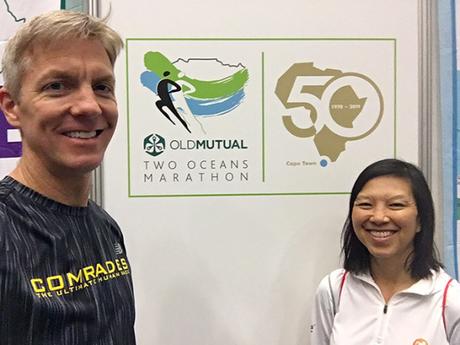
The OMTOM expo (held in the Cape Town International Convention Centre) was similar in size to a big-city US expo and smaller than the Comrades expo, though with many of the same vendors. I took the opportunity to stock up on my Maurten supply and to say hi to Lindsey Parry, the official Comrades coach whose podcast advice played a huge role in my Comrades success each of the past two years. Unfortunately, as someone with an Achilles heel for running shoes, I was disappointed to find Adidas (the official apparel sponsor) hadn’t created a limited-edition OMTOM shoe, which felt like a no-brainer. Luckily we were able to catch the excellent movie “Run As One” at the expo, plus I bought the coffee table book “Celebrating 50 Years of the Two Oceans Marathon.” So I had no trouble getting my OMTOM memorabilia fix.
(By the way, if you’re able to hit the expo on Thursday and avoid the rush, I’d recommend you do so unless you fancy your expo like Walmart on Black Friday. Don’t worry, you’ll have plenty of time for close-packed camaraderie in the start corral on race day.)
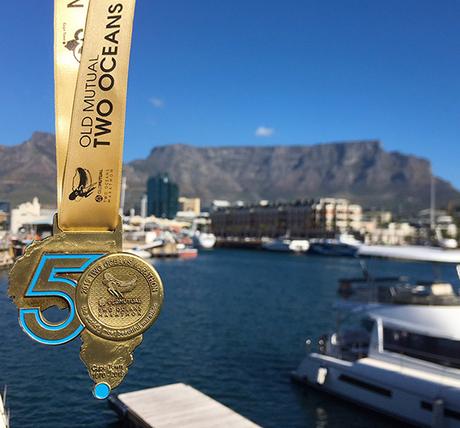
SWAG: As far as swag, the 50th Two Oceans Marathon was about one thing for me — the medal. And it did not disappoint, with a gold ribbon and a large bronze “50” emblazoned on the African continent in profile. Seeing the medal hang on my wall at home, I’m actually glad I didn’t finish the race in less than six hours, since the “5” outlined in blue that distinguishes me as a sub-7 finisher stands out boldly and complements nicely the blue dot situated over Cape Town on the outline of Africa.
And though it’s nice material with a decent design, the official Adidas race tee doesn’t come out of the closet much — you’ve got to have game to pull off seafoam green, and especially when you’ve got skin the color of Casper the Friendly Ghost. Luckily, the OMTOM store at the expo was selling a different shirt that came in a much more reasonable shade of blue.
Curious about Comrades? Read more about my 2017 “up” run (Durban to Pietermaritzburg) experience HERE and my 2018 “down” run (Pietermaritzburg to Durban) experience HERE.
Can’t get enough Two Oceans? Check out 17-time finisher and Blue Number Club member Stuart Mann’s excellent love letter to the Two Oceans Marathon HERE.
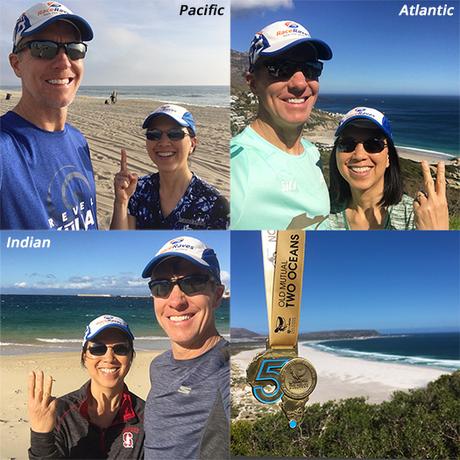
Los Angeles to Cape Town — one week, three oceans and one iconic race
RaceRaves rating:
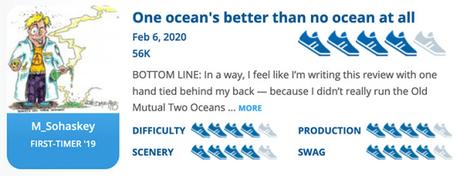
FINAL STATS:
Apr 20, 2019 (start time 6:40 am, sunrise 7:12 am)
34.95 miles in Cape Town, South Africa
Finish time & pace: 6:07:11 (first time running the Two Oceans Marathon), 10:30/mile
Finish place: 5,436 overall, 1,623/3,174 in M 40-49 age group
Number of finishers: 12,108 (8,618 men, 3,490 women)
Race weather: partly cloudy (59°F) with light rain at the start, partly cloudy at the finish
Elevation change (Garmin Connect): 2,405 ft gain, 2,212 ft loss
Elevation min, max: 10 ft, 1,031 ft
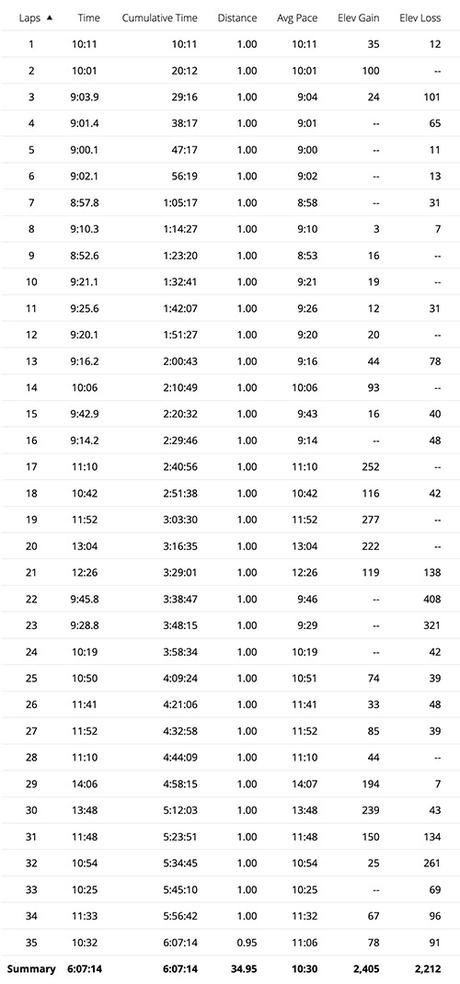
Course splits (in miles) for the 2019 Two Oceans Marathon
